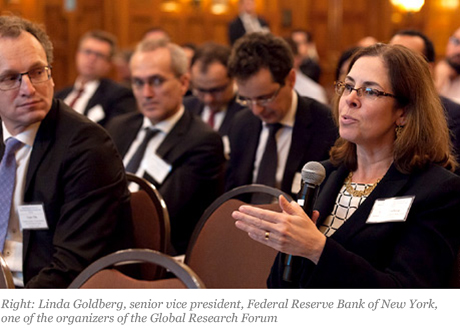At the N.Y. Fed: Capital Flows, Policy Dilemmas, and the Future of Global Financial Integration

The New York Fed recently hosted the third bi-annual Global Research Forum on International Macroeconomics and Finance, an event organized in conjunction with the European Central Bank (ECB) and the Federal Reserve Board. Bringing together a diverse group of academics, policymakers, and market participants, the two-day conference (November 17-18) was aimed at promoting discussion of frontier research on empirical and theoretical issues in international finance, banking, and open-economy macroeconomics. Understanding the drivers and implications of international capital flows was a major area of focus, along with the policy challenges posed by global financial integration.
U.S. Banks’ Changing Footprint at Home and Abroad
Highlights from the Global Research Forum on International Macroeconomics and Finance
International financial flows are a key feature of the global landscape and are relevant in many ways for central banks.
How Do Liquidity Conditions Affect U.S. Bank Lending?
he recent financial crisis underscored the importance of understanding how liquidity conditions for banks (or other financial institutions) influence the banks’ lending to domestic and foreign customers.
Cross‑Country Evidence on Transmission of Liquidity Risk through Global Banks
Over the past thirty years, the typical large bank has become a global entity with subsidiaries in many countries.
Measuring Global Bank Complexity
Paraphrasing a famous Supreme Court opinion: “I know bank complexity when I see it.”
What’s News?
Linda S. Goldberg Economic news moves markets. Most analyses find that economic news is incorporated quickly (within minutes) into asset prices, with some measurable persistence of these effects, and with some spillovers across national borders. Some types of announcements—for example, U.S. nonfarm payrolls announcements—generate much larger asset price responses than others. Generally, news that is […]
Ring‑Fencing and “Financial Protectionism” in International Banking
Some market watchers and academic researchers are concerned about a “Balkanization” of banking, owing to a sharp decline in cross-border international banking activity, and an increased home bias of financial transactions.
Follow That Money! How Global Banks Manage Liquidity Globally
Banks increasingly move money around the world.
How Has the Business of International Banking Changed?
In this post, I focus on the broad historical progression of international banking activity.











 RSS Feed
RSS Feed Follow Liberty Street Economics
Follow Liberty Street Economics